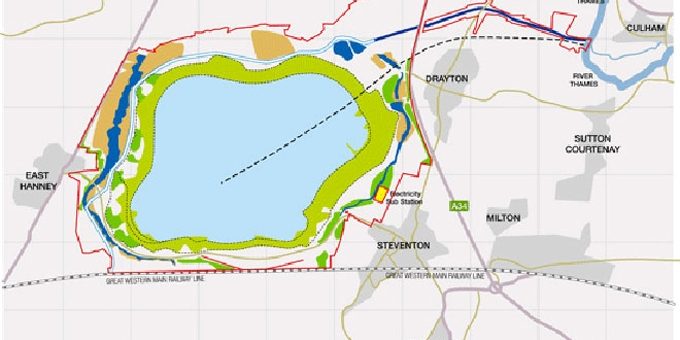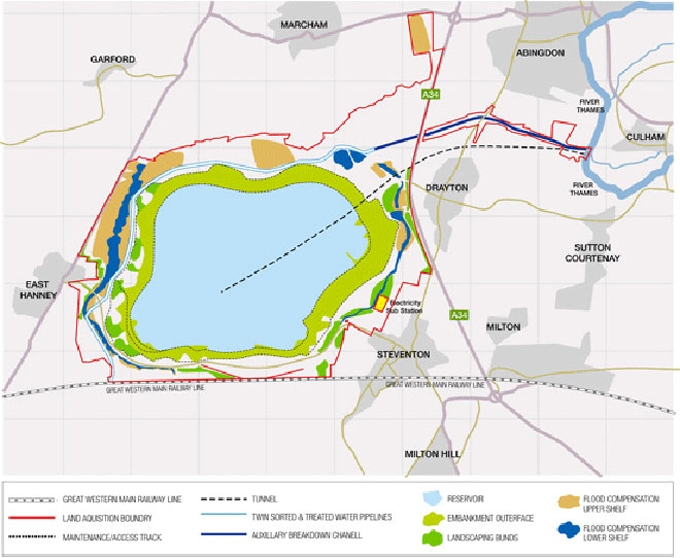The Abingdon Reservoir Proposal

1st June 2012

CPRE Oxfordshire opposes the proposed Upper Thames Reservoir near Abingdon. Thames Water should concentrate on reducing leakage, improving water conservation and identifying more environmentally sustainable solutions to future water supply.
Lower rainfall, increased consumer consumption, housing and industrial growth and large-scale leakage are all contributing to a growing water shortage in the southeast.
To alleviate the shortage Thames Water propose a large new reservoir in the Steventon and Hanney area, near Abingdon, Oxfordshire. It would store approximately 150 billion litres (equal to 33 billion gallons), an area of agricultural land about 10 sq km. The chosen site is flat clay vale, so the water will need to be contained by an embankment; the maximum height will be 25 metres (80 feet) in height and would only occur opposite Marcham.
We believe the proposed development will have a major impact on the local landscape and surrounding villages.
Bruce Tremayne of CPRE Oxfordshire criticises the rush to construct a reservoir before other options have been exhausted:
“We face a growing water shortage in the South East. But before we disrupt and destroy so much of Oxfordshire’s landscape, we must save water rather than waste it. The priority must be to change the landscape of peoples’ minds rather than the landscape of Oxfordshire. Every householder should think about how to use less water and Thames Water must better manage existing supplies before it pushes ahead with giant engineering projects which destroy landscapes.”
We call for a series of actions by Thames Water, the Environmental Agency, Ofwat and the public:
Reduce water leakage
Rates of water loss in the Thames area are too high. In the year to March 2007, Thames Water lost 790 million litres a day through leakage. This is the equivalent of about 235 litres for every property—much more than the household consumption of 154 litres a day (source: Thames Water). Ofwat calls for a reduction of leakage to 725 million litres a day by 2010.
Encourage lower water usage
There is an urgent need for research into water usage in the region and incentives for reduction of use. At a minimum, we call for metering of all consumers in the southeast before plans for the reservoir are considered. (Thames Water installed meters in just 0.32% of households in its area in 2003/04). All new houses need to be built to ensure minimum water usage.
Pursue alternative options
All available options to the reservoir need to be considered including a cluster of smaller storage areas and replenishment of aquifers. Landscape and environmental considerations must take equal place with financial factors in any review of these proposals.
Reduce personal usage
Regardless of the Thames Water proposal, South East England is short of water. You can help by reducing your own water consumption (and your water bills!):
1. Ask Thames Water to install a water meter, its free: ring their Customer Centre on: 0845 9200 888.
2. Reduce your household use: see Thames Water’s top ten water-saving tips.
3. If you are a teacher or parent, you’ll find useful information for children on the Water in Schools and Wateraid websites.
History
In April 2007, the Environment Agency published regulations that meant that Thames Water had to begin the examination of the case for the reservoir again and the whole planning process was delayed by at least two years.
Thames Water published its draft Water Resources Management Plan (WRMP) in May 2008.
Following consultations and consideration of Thames Water’s Statement of Response, on 5 August 2009 it was announced that the Secretary of State had called for a public inquiry into the draft Water Resources Management Plan.
In September 2009 a revised draft Water Resources Management Plan was published by Thames Water to address a number of issues raised in the first draft and provide additional information.
On 8 December 2009 DEFRA published details of the Public Inquiry, which was held during the summer of July, 2010.
CPRE Oxfordshire in conjunction with CPRE Kent presented its Statement of Case against the reservoir proposals.
The Vale of White Horse District Council and Oxfordshire County Council also presented a Statement of Case outlining various concerns, including the impact of the reservoir on the local landscape.
In May 2011 the Secretary of State called for further technical work, including the option of a smaller reservoir, half the size of the original Abingdon proposal. DEFRA and the Environment Agency are now advising Thames Water on the work required to satisfactorily complete the 2009 Water Resources Management Plan (WRMP), the 2012 Annual Review and the 2013 WRMP.
